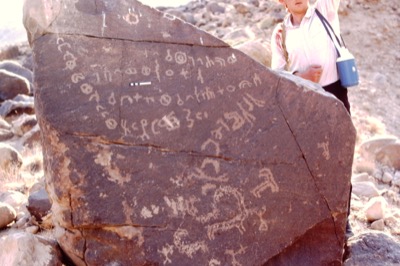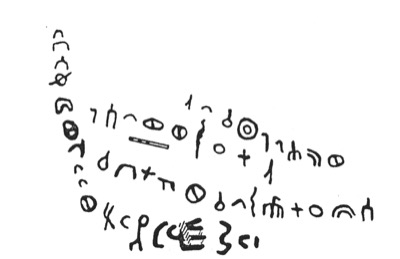Siglum: KJC 46 Script: Hismaic
2)
3)
Transliteration
1) w m ḥll ḍy rh
2) ht ʿs²w w rs¹l
3) s¹mʿt ḏs²ry w ktby
Translation
1) And whoever has encamped, whilst taking refuge, in the low-lying ground
2) Give an [offering of ] an evening meal and milk
3) That Ḏs²ry and Ktby may hear
Apparatus Criticus
King (1990: 307–309) commented: "The inscription is written in three lines, one below the other and all reading from right to left. The letters are written with a vertical stance although the text reads horizontally and some of them have forms which are slightly difference from those found in the rest of the texts from these sites, cf. KJC 84 and see Ch.2.H.3.
After the introductory particle w one might expect a verb followed by a subject on the basis of other examples: mḥl, Ar. maḥala ‘it was barren’; form II maḥḥala ‘he strengthened’; form III māḥala ‘he acted cunningly’. A problem, however, arises with the next two or three letter lḍ or lḍy for which I cannot find an attested root.
An alternative would be to read the first word as the substantive mḥl ‘a halting place’ Ar. maḥal, the second l as li indicating possession and ḍyrh as a proper name: w mhl l ḍyrh ‘And the halting place belongs to ḍyrh’. Against this interpretation is that in examples where possession is expressed, the object possessed is usually placed after the preposition and the possessor (see, for instance, JS 67 --w lh rgm, KWM 15 --w lh ṯyt). The name ḍyrh would be new.
mḥll, on the other hand is attested as a name in Safaitic (Harding 1971: 531) and ḍyr could be a form of the Ar. verb ḍāra ‘it harmed’, here with a person as the subject; -h would be the third person pronoun suffix: w mḥll ḍrh ‘And mḥll harmed him’. The context of this interpretation would be unclear.
The second line of the text does not begin with a conjunction suggesting it is dependent on the first which would be the case if the latter is translated as a relative clause. m as the relative particle, Ar. man, occurs frequently in Safaitic as such (see, for instance, WH 40, 1679). ḥll Ar. ḥalla ‘he alighted or settled’ occurs in Safaitic (WH 54 etc.). Ar. ḍawaya means ‘he took refuge’ and here occurs as ḍy, the maṣdar, dayy used in a ḥāl clause (compare AMJ 5 in Appendix 2 which reads at the end --f byt w ḍy). rh, Ar. rahw ‘a depressed place where water collects’ also has the contrary meaning ‘elevated place’ but the position of the rock within a wadi near the main watercourse suggests that the former translation should be adopted. rh would be an object dependent on ḥll rather than ḍy.
In line 2 I have translated ht from Ar. hāti, āti (Wright I: 36 rem.d) ‘give’. The Ar. root ʿšw has the general meaning of feeding or undertaking something in the evening, ʿašāʾ is ‘an evening meal’ and ʿišw ‘a bowl of milk drunk when the sheep or goats return in the afternoon or evening’ and the word should perhaps be glossed as ‘an offering of evening food’. rs¹l might be derived from Ar. risl ‘milk’. The text ends with an invocation which occurs elsewhere, see Ch.4.C.4. In the other texts the prayer occurs at the beginning or stands alone and possibly expresses the purpose of ‘giving’ or ‘offering’ the evening meal and milk".
Commentary
Subjects
Camping
Deity
Prayer
Religion
Country: Jordan
Region: ʿAqabah Governorate
Site: Wādī Ǧudayid, site C
Latitude: 29.913152
Longitude: 35.4973355
Present Location: In situ
Field collector: Geraldine King
References:
Harding, G.L. An Index and Concordance of Pre-Islamic Arabian Names and Inscriptions. (Near and Middle East Series, 8). Toronto: University of Toronto Press, 1971.
[KJC] King, G.M.H. Early North Arabian Thamudic E. A preliminary description based on a new corpus of inscriptions from the Ḥismā desert of southern Jordan and published material. Ph.D thesis, School of Oriental and African Studies, University of London, 1990. [Unpublished]. 1990. Pages: 307–309
Wright, W. A Grammar of the Arabic Language. Translated from the German of Caspari and edited with numerous additions and corrections. Third edition revised by W. Robertson Smith and M.J. de Goeje. (2 volumes). Cambridge: Cambridge University Press, 1896-1898 (3rd ed.). Volume: I Pages: 36
URL of this record (for citation): http://krc.orient.ox.ac.uk/ociana/corpus/pages/OCIANA_0049111.html

